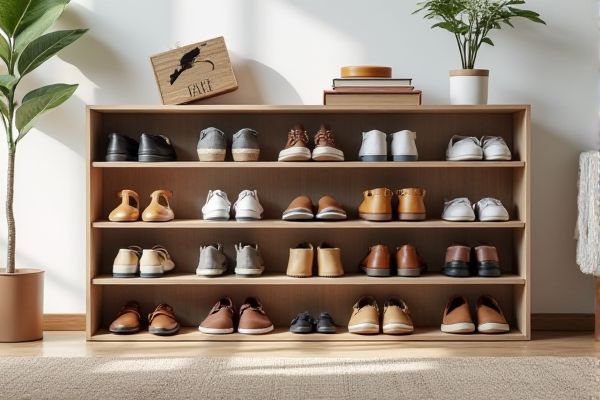
Flat shoe racks provide uniform storage with easy stacking options, maximizing floor space and keeping shoes in a simple, organized manner. Explore the rest of the article to find out which shoe rack design suits your storage needs best.
Table of Comparison
| Feature | Flat Shoe Rack | Angled Shoe Rack |
|---|---|---|
| Shoe Visibility | Low; shoes are stacked flat | High; shoes displayed at an angle |
| Accessibility | Moderate; shoes easy to place but can be hard to see | High; shoes easier to grab and view |
| Space Efficiency | Good; takes less vertical space | Moderate; requires more vertical space |
| Design Style | Simple and minimalistic | Modern and ergonomic |
| Suitability | Ideal for small spaces and flat placement | Best for quick selection and display |
| Price Range | Generally lower cost | Typically higher cost due to design |
Introduction to Shoe Rack Designs
Flat shoe racks provide a simple, space-efficient solution, ideal for maximizing floor area with uniform shoe placement. Angled shoe racks enhance visibility and access, using tilted shelves that allow shoes to be displayed more prominently while saving vertical space. Both designs cater to different organizational needs, balancing convenience and aesthetic appeal in shoe storage.
Overview of Flat Shoe Racks
Flat shoe racks provide a straightforward storage solution with horizontal shelves that maximize space by stacking shoes side by side, perfect for compact areas or closets. Their design allows for easy visibility and quick access to Your footwear while maintaining a tidy, organized look. Unlike angled racks, flat racks avoid slanting, reducing the risk of shoes slipping off and offering stable support for heavier or bulkier shoes.
Key Features of Angled Shoe Racks
Angled shoe racks feature slanted shelves that allow shoes to be displayed for easy visibility and access, optimizing storage space by stacking footwear vertically without compromising accessibility. Their design often includes raised edges or lips on each shelf to prevent shoes from slipping off, enhancing stability especially in narrow or compact areas. Constructed from materials like wood, metal, or plastic, these racks combine durability with aesthetic appeal, making them suitable for various home decors while maximizing organization efficiency.
Space Efficiency Comparison
Flat shoe racks maximize horizontal space by allowing shoes to be stored side by side, making them ideal for narrow or low-clearance areas. Angled shoe racks optimize vertical space, enabling a tiered display that accommodates more pairs in a compact footprint, perfect for small closets or entryways. Your choice depends on whether you prioritize floor space or vertical organization for efficient shoe storage.
Shoe Accessibility and Organization
Flat shoe racks provide straightforward accessibility by allowing shoes to be placed side-by-side on a single level, making it easy to view and grab pairs quickly. Angled shoe racks enhance organization by angling shoes upward, which maximizes vertical space and improves visibility of shoe fronts, facilitating easier selection and reducing clutter. Both designs optimize shoe storage but differ in efficiency depending on space constraints and user preference for quick access versus space-saving organization.
Aesthetic Appeal and Style
Flat shoe racks offer a sleek, minimalist design that complements modern interiors by creating a clean and organized look. Angled shoe racks provide a dynamic visual effect, showcasing shoes more prominently and adding depth to your space with a stylish, tiered display. Your choice between these options can enhance the overall aesthetic appeal, balancing functionality with your personal decor style.
Durability and Maintenance
Flat shoe racks typically offer enhanced durability due to their simple, sturdy design that evenly supports shoe weight, reducing stress on materials. Angled shoe racks may require more maintenance as their slanted shelves can loosen over time and accumulate dust more easily in crevices. Choosing a flat shoe rack can simplify upkeep and extend the lifespan of your shoe storage solution.
Best Uses for Flat vs Angled Shoe Racks
Flat shoe racks are ideal for maximizing storage in narrow spaces, providing stability for various shoe types, and allowing easy stacking of shoes without distortion. Angled shoe racks offer enhanced visibility and airflow, making them perfect for entryways or closets where quick access and ventilation are essential. Choosing between flat and angled racks depends on space constraints and the importance of shoe accessibility and organization.
Price and Value Considerations
Flat shoe racks typically offer a lower price point due to simpler construction and materials, making them a budget-friendly option for basic storage needs. Angled shoe racks often come with a higher cost reflecting enhanced visibility and space efficiency, providing greater value for users prioritizing organized display and easy access. Choosing between flat and angled shoe racks depends on balancing upfront expense against long-term convenience and room aesthetics.
Choosing the Right Shoe Rack for Your Needs
Flat shoe racks provide a straightforward, space-efficient solution ideal for maximizing horizontal storage in compact areas. Angled shoe racks offer enhanced visibility and easier access to each pair, making them perfect for displaying and quickly selecting footwear. Consider your available space and how you prioritize accessibility when choosing the right shoe rack for your needs.
 homyna.com
homyna.com